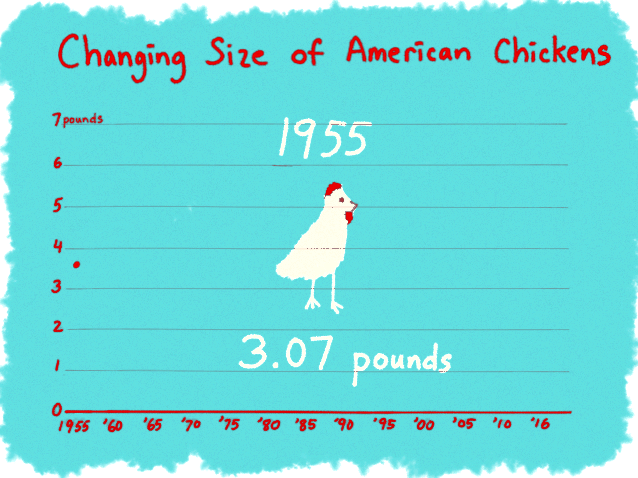
Getty Images
Once we begin 2017, Americans look back at 2016 up to now another year with record-high chicken consumption—an average of 89.6 pounds per person. That’s greater than three occasions around our grandma and grandpa ate.
Chickens we eat today are two times as large as these were six decades ago. In 1955, the typical weight of chickens offered on market was 3.07 pounds, as the number for that first 1 / 2 of 2016 was 6.18 pounds, based on National Chicken Council, a nonprofit trade organization located in Washington, D.C.
First of all, chicken breeds today tend to be more cost-efficient than six decades ago. To be able to shorten production cycle and cut cost, the selective breeding for broilers — chickens elevated for meat instead of eggs — prefers faster rate of growth and greater feed-to-meat ratio — meaning the pounds of feed it requires to achieve 1 lb of meat.
Time it required to develop a recently-hatched chicken for market continues to be cut half because the 1990s to simply under 7 days from 16 days in 1925, data in the National Chicken Council demonstrated. And it takes only under half feed to obtain the equivalent meat.

Animated GIF by Stefie Gan.
The popularity began using the 1948 contest that asked maqui berry farmers nationwide to build up the “Chicken of Tomorrow” with specific goals — bigger, meatier, faster growth. Consequently, Arbor Acre breed, the crossbreed of these two winners, is just about the grandma and grandpa on most commercial meat chicken we eat today worldwide.
There have been massive genetic variations because of selective breeding by raising chicken breeds from various eras under identical conditions, a 2014 study by researchers in the College of Alberta, Canada, observed. The end result was stunning: In the same age, the 2005 breed had grown to around four occasions as heavy because the 1957 breed, despite being given exactly the same food.
Next, chicken companies also have achieved greater efficiency within their raising process — both when it comes to quantity and size — through economy of scale and evolved chicken science.
“Chicken was incredibly costly and largely considered an extravagance good,” stated Emelyn Rude, author from the 2016 book “Tastes Like Chicken: Past America’s Favorite Bird,” “In the 1950s and before, chickens were only offered entirely form, which entailed a remarkably labor intensive procedure for butchering and processing before they may be cooked and eaten in your own home.Inches
Nowadays, most chickens spend their whole lives in a tiny confinement along with a large number of others from birth to dying, without any possible ways to roam or perhaps move. They’re elevated to achieve the “slaughter weight” as quickly as possible through excessive feeding and loss of focus. Although hormones and steroids within the chicken industry are prohibited through the Fda, antibiotics are regularly utilized by farms as growth agents.
“Scientists learn more about chicken diet needs than every other creature in the world, and thus advanced chicken feed helps lead for their an explosion rate,” stated Rude.
Thirdly, the American diet has possessed a dramatic shift toward processed food. As increasing numbers of pre-cooked and convenience products grew to become available, bland, cheap and healthy chicken grew to become the right item to feature in these kind of meals, also it made financial sense for manufacturers to boost bigger chickens for TV dinners along with other prepared foods. “Most cookbooks beginning within the 1970s only demand boneless, skinless chicken white meat, something that was virtually non-existent prior to the creation of chicken processing,” Rude told MarketWatch.
Margaret Heffernan: Why it’s time to forget the pecking order at work
Tags: chickens
Comments are closed here.
